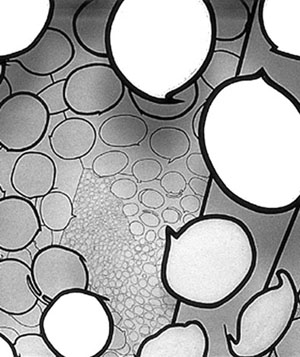
But with the emergence of British and American pop art, starting in the late 1950s, comics have extended their realm into conventional modern art. Long standing cultural hierarchy collapsed and the boundaries between pop and elite culture got blurred. The images of comics broke through these cracks and seeped into various aspects of culture.
Keeping up with this contemporary tradition, Ewha Womans University Museum is currently featuring an innovative exhibition, "Comics in Art, Art in Comics," which will run through June 30. This is quite a departure from its previous exhibitions, which mainly covered traditional Korean art or conventional modern art.
A total of 84 pieces of art by 66 cartoonists, animators, and artists are on display. The exhibition is divided into four themes: "Iconography of Our Times," "Speaking Figures," "Between Panels," and "Satire, Symbols, Signs."
"Iconography of Our Times" deals with the ways and intentions that the images of comics came to intermingle with conventional art. "Atomouse" by Lee Dong-gi and "Scream" by Park Mi-na are fine examples of this theme. Atom and Mickey Mouse are recreated as Atomouse and the image of Charley Brown was simplified in "Scream." Cartoons and comic books from mid-1900s to 1980s, such as "Dooly," are also displayed.
"Speaking Figures" reflects upon the contemporary formative art, and how it has uprooted itself from one of its functions; speaking and interacting with the public. This section features works made in reaction to this development. Comics from the early and mid-20th century that have experimented with various possible ways of "speaking" are exhibited: Park Ki-jun"s "Viva Dutongi" incorporated image and text in a child"s diary picture-like way.
In comics, panels are used as a way to limit time and space in each scene. Therefore, a reader must imagine what will happen in white, blank spaces in-between panels before going on to the next picture.
"Between Panels" displays comics with many cuts (panels) in an effort to represent the continuity and flow of comics. "Bomyeongsiudo" is what grabs the attention here. This ten-cut comic strip from the 10th century is an interpretation of Buddhist doctrines and has its significance in the fact that it shows the origin of Korean comics.
"Satire, Symbols, Signs" perhaps best conveys social functions that comics can perform. Because comics can contain both words and pictures to deliver their message, it is often easier for artists to use them as satires about society. ?
"Mondrian Hotel" by Joo Jae-hwan deserves special attention. Setting the Dutch abstract artist Piet Mondrian"s famous lattice style as a background, Joo filled every empty space with images circulated in Korean art circles. Joo critiques Korea"s problematic art circles, which are often too busy copying Western style to the extent that they nelect their duty to inherit, recreate, and develop Korea"s own traditional art.
The third floor of the museum building is open to the public as a reading room for comic books. There, a visitor can rest and enjoy comics. The room holds a collection of about 100 comic books, with some available for sale.
Kim Jung-sun, a housewife living in Oksu-dong, sums up her impressions this way: "I have come to every exhibition that Ewha Museum has held since 2000, and what I saw was very different from the previous ones, so I was a bit shocked at first. However, I think it is good for audiences to realize that comics have been introduced in so many aspects of our lives and that they no longer remain marginalized in art." And ironically enough, comics have again found a way to reach the general public, even if this time from the high perch of a museum gallery collection.
arielle@ewha.ac.kr

